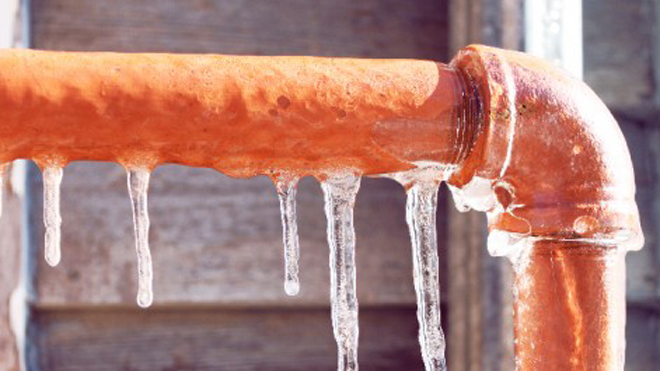Important Tips to Protect Against Frozen Plumbing in Winter
Important Tips to Protect Against Frozen Plumbing in Winter
Blog Article
The publisher is making a few good annotation on the subject of Helpful Tips to Prevent Frozen Pipes this Winter as a whole in this content underneath.

Cold weather can wreak havoc on your plumbing, especially by freezing pipes. Right here's exactly how to prevent it from taking place and what to do if it does.
Intro
As temperatures drop, the risk of icy pipes increases, possibly leading to pricey fixings and water damage. Recognizing just how to stop frozen pipes is vital for homeowners in cool environments.
Prevention Tips
Shielding vulnerable pipelines
Cover pipes in insulation sleeves or use warm tape to secure them from freezing temperature levels. Concentrate on pipes in unheated or external locations of the home.
Home heating strategies
Keep interior spaces adequately heated, specifically locations with plumbing. Open closet doors to allow warm air to circulate around pipes under sinks.
Exactly how to identify icy pipes
Search for decreased water circulation from faucets, unusual odors or sounds from pipelines, and visible frost on exposed pipes.
Long-Term Solutions
Structural changes
Take into consideration rerouting pipelines far from exterior wall surfaces or unheated locations. Add added insulation to attic rooms, cellars, and crawl spaces.
Updating insulation
Invest in high-grade insulation for pipelines, attics, and wall surfaces. Appropriate insulation aids keep consistent temperatures and lowers the risk of frozen pipelines.
Securing Outside Plumbing
Garden hose pipes and outside taps
Disconnect and drain pipes garden pipes before winter months. Set up frost-proof faucets or cover outdoor faucets with shielded caps.
Recognizing Icy Pipes
What creates pipelines to freeze?
Pipelines freeze when exposed to temperature levels listed below 32 ° F (0 ° C) for prolonged periods. As water inside the pipes ices up, it expands, putting pressure on the pipe wall surfaces and possibly causing them to burst.
Risks and damages
Frozen pipelines can lead to supply of water disruptions, property damages, and pricey repairs. Ruptured pipelines can flooding homes and trigger substantial architectural damages.
Indicators of Frozen Pipes
Recognizing frozen pipelines early can avoid them from breaking.
What to Do If Your Pipes Freeze
Immediate activities to take
If you suspect frozen pipes, keep faucets available to eliminate stress as the ice thaws. Use a hairdryer or towels taken in warm water to thaw pipelines gradually.
Final thought
Protecting against frozen pipes needs aggressive procedures and fast feedbacks. By comprehending the causes, indications, and preventive measures, homeowners can safeguard their plumbing during cold weather.
5 Ways to Prevent Frozen Pipes
Drain Outdoor Faucets and Disconnect Hoses
First, close the shut-off valve that controls the flow of water in the pipe to your outdoor faucet. Then, head outside to disconnect and drain your hose and open the outdoor faucet to allow the water to completely drain out of the line. Turn off the faucet when done. Finally, head back to the shut-off valve and drain the remaining water inside the pipe into a bucket or container. Additionally, if you have a home irrigation system, you should consider hiring an expert to clear the system of water each year.
Insulate Pipes
One of the best and most cost-effective methods for preventing frozen water pipes is to wrap your pipes with insulation. This is especially important for areas in your home that aren’t exposed to heat, such as an attic. We suggest using foam sleeves, which can typically be found at your local hardware store.
Keep Heat Running at 65
Your pipes are located inside your walls, and the temperature there is much colder than the rest of the house. To prevent your pipes from freezing, The Insurance Information Institute suggests that you keep your home heated to at least 65 degrees, even when traveling. You may want to invest in smart devices that can keep an eye on the temperature in your home while you’re away.
Leave Water Dripping
Moving water — even a small trickle — can prevent ice from forming inside your pipes. When freezing temps are imminent, start a drip of water from all faucets that serve exposed pipes. Leaving a few faucets running will also help relieve pressure inside the pipes and help prevent a rupture if the water inside freezes.
Open Cupboard Doors
Warm your kitchen and bathroom pipes by opening cupboards and vanities. You should also leave your interior doors ajar to help warm air circulate evenly throughout your home.

We were shown that article about How to prepare your home plumbing for winter weather from a good friend on another site. Do you know about someone else who is sincerely interested in How to prepare your home plumbing for winter weather? Take a moment to share it. Bless you for being here. Revisit us soon.
Call Today Report this page